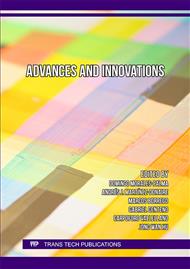[1]
Chen NJ, Thonnerieux M, Ducloux R, Wan M, Chenot JL. Parametric study of riveted joints. International Journal of Material Forming (2014) 65–79.
DOI: 10.1007/s12289-012-1114-7
Google Scholar
[2]
Repetto EA, Radovitzky R, Ortiz M, Lundquist RC, Sandstrom DR. A finite element study of electromagnetic riveting. J Manuf Sci Eng 1999;121:61–8.
DOI: 10.1115/1.2830576
Google Scholar
[3]
Reinhall PG, Ghassaei S, Choo V. An analysis of rivet die design in electromagnetic riveting. Journal of Vibration Acoustics Stress and Reliability in Design (1988), 110(1):65.
DOI: 10.1115/1.3269482
Google Scholar
[4]
Cao ZQ. A studying on electromagnetic riveting [dissertation]. Xi'an: Northwestern Polytechnical University; (2000)
Google Scholar
[5]
P. Liu, K. Zhang, An experimental study on fatigue life of interference-fit joint, ACTA Aeronautica et Astronautica Sinica 12 (1991) 545–548.
Google Scholar
[6]
Cao ZQ, Cardew HM. Interference-fit riveting technique in fiber composite laminates. Aerospace Science and Technology (2006), 10(4): 327–30.
DOI: 10.1016/j.ast.2005.11.003
Google Scholar
[7]
Information on https://www.aircraftsystemstech.com/2018/12/solid-shank-rivet-aircraft-structural.html
Google Scholar
[8]
Philippe Viot , Ludovic Balle`re, Laurent Guillaumat, Jean-Luc Lataillade, Scale effects on the response of composite structures under impact loading. Engineering Fracture Mechanics 75 (2008) 2725–2736
DOI: 10.1016/j.engfracmech.2007.03.001
Google Scholar
[9]
Hao Jiang, Chaochao Zeng, Guangyao Li, Junjia Cui. Effect of locking mode on mechanical properties and failure behavior of CFRP/Al electromagnetic riveted joint. Composite Structures 257 (2021) 113162
DOI: 10.1016/j.compstruct.2020.113162
Google Scholar
[10]
Joining Technique of Composite Structures, Aviation Industry Press, Beijing, 1985, p.119, translated by G. Zhang.
Google Scholar
[11]
QJ 782A-2005, People's Republic of China Aerospace Industry Standard: General Technical Requirements for Riveting, second ed., National Defense Science and Technology Industry Committee, Beijing, 2005.
Google Scholar
[12]
Szolwinski, M P. (1998). The Mechanics and Tribology of Fretting Fatigue with Application to Riveted Lap Joints,‖Ph D Thesis, School of Aeronautics and Astronautics, Purdue Univ.,West Lafayette, IN.
Google Scholar
[13]
Safari, Mehdi & Joudaki, Jalal. (2019). Coupled Eulerian-Lagrangian (CEL) Modeling of Material Flow in Dissimilar Friction Stir Welding of Aluminum Alloys. 10-19.
Google Scholar
[14]
Sakbana, A & Mashrei, Mohammed. (2020). Finite Element Analysis of CFRP-Reinforced Concrete Beams. Revista Ingenieria de Construccion. vol 35.
DOI: 10.4067/S0718-50732020000200148
Google Scholar
[15]
Zhang, Shunyi & Kinsey, Brad. (2021). Influence of Material Properties on Interfacial Morphology during Magnetic Pulse Welding of Al1100 to Copper Alloys and Commercially Pure Titanium. Journal of Manufacturing and Materials Processing. 5. 64.
DOI: 10.3390/jmmp5020064
Google Scholar
[16]
Information on https://www.azom.com/article.aspx?ArticleID=6215
Google Scholar



